Cabinet of the United Kingdom
The Cabinet of the United Kingdom is the senior decision-making body of His Majesty's Government.[1] A committee of the Privy Council, it is chaired by the prime minister and its members include secretaries of state and other senior ministers.
.svg.png.webp) | |
.jpg.webp) Cabinet Room, 10 Downing Street, Prime Minister David Cameron (2010–2016) is talking to US Secretary of State John Kerry (2013–2017) | |
| Cabinet overview | |
|---|---|
| Formed | 1644 |
| Type | Committee of the Privy Council |
| Jurisdiction | His Majesty's Government |
| This article is part of a series on |
| Politics of the United Kingdom |
|---|
.svg.png.webp) |
|
The Ministerial Code says that the business of the Cabinet (and cabinet committees) is mainly questions of major issues of policy, questions of critical importance to the public and questions on which there is an unresolved argument between departments.[2]
History
Until at least the 16th century, individual officers of state had separate property, powers and responsibilities granted with their separate offices by royal command, and the Crown and the Privy Council constituted the only co-ordinating authorities. In England, phrases such as "cabinet counsel", meaning advice given in private, in a cabinet in the sense of a small room, to the monarch, occur from the late 16th century, and, given the non-standardised spelling of the day, it is often hard to distinguish whether "council" or "counsel" is meant.[3] The OED credits Francis Bacon in his Essays (1605) with the first use of "Cabinet council", where it is described as a foreign habit, of which he disapproves: "For which inconveniences, the doctrine of Italy, and practice of France, in some kings' times, hath introduced cabinet counsels; a remedy worse than the disease".[4] Charles I began a formal "Cabinet Council" from his accession in 1625, as his Privy Council, or "private council", and the first recorded use of "cabinet" by itself for such a body comes from 1644, and is again hostile and associates the term with dubious foreign practices.[3]
There were ministries in England led by the chief minister, which was a personage leading the English government for the monarch. Despite primary accountability to the monarch, these ministries, having a group of ministers running the country, served as a predecessor of the modern perspective of cabinet. After the ministry of Lord Stanhope and Lord Sunderland collapsed, Sir Robert Walpole rose to power as First Lord of the Treasury. Since the reign of King George I the Cabinet has been the principal executive group of British government. Both he and George II made use of the system, as both were not native English speakers, unfamiliar with British politics, and thus relied heavily on selected groups of advisers. The term "minister" came into being since the royal officers "ministered" to the sovereign. The name and institution have been adopted by most English-speaking countries, and the Council of Ministers or similar bodies of other countries are often informally referred to as cabinets.
.jpg.webp)
The modern Cabinet system was set up by Prime Minister David Lloyd George during his premiership, 1916–1922, with a Cabinet Office and Secretariat, committee structures, unpublished minutes, and a clearer relationship with departmental Cabinet ministers. The formal procedures, practice and proceedings of the Cabinet remain largely unpublished.
This development grew out of the exigencies of the First World War, where faster and better co-ordinated decisions across Government were seen as a crucial part of the war effort. Decisions on mass conscription, co-ordination worldwide with other governments across international theatres, and armament production tied into a general war strategy that could be developed and overseen from an inner "War Cabinet". The country went through successive crises after the war: the 1926 United Kingdom general strike; the Great Depression of 1929–32; the rise of Bolshevism after 1917 and Fascism after 1922; the Spanish Civil War 1936 onwards; the invasion of Abyssinia 1936; the League of Nations Crisis which followed; and the re-armament and resurgence of Germany from 1933, leading into another World War. All these demanded a highly organised and centralised Government centred on the Cabinet.
Composition
The prime minister decides the membership and attendees of the Cabinet.[5]
The total number of Cabinet ministers who are entitled to a salary is capped at 21, plus the lord chancellor, who is paid separately.[6] Some ministers may be designated as also attending Cabinet, like the attorney general,[7] as "...it has been considered more appropriate, in recent times at any rate, that the independence and detachment of his office should not be blurred by his inclusion in a political body – that is to say the Cabinet – which may have to make policy decisions upon the basis of the legal advice the law officers have given."[8]
The Cabinet is a committee of the Privy Council (though this interpretation has been challenged) and, as such, all Cabinet ministers must be privy counsellors.[9]
Members of the Cabinet are by convention chosen from members of the two houses of Parliament, as the Peel convention dictates that ministers may only be recruited from the House of Commons or the House of Lords, although this convention has been broken in the past for short periods. Patrick Gordon Walker is perhaps the most notable exception: he was appointed to the Cabinet despite losing his seat in the 1964 election, and resigned from Cabinet after running and losing in a by-election in January 1965.[10] Sometimes, when a minister from neither House is appointed, they have been granted a customary peerage.[11] The Cabinet is now made up almost entirely of members of the House of Commons.[7]
Civil servants from the Cabinet Secretariat and special advisors (on the approval of the prime minister) can also attend Cabinet meetings, but neither take part in discussions.[1]
It has been suggested that the modern Cabinet is too large, including by former Cabinet Secretary Mark Sedwill and scholars Robert Hazell and Rodney Brazier.[12][13] Robert Hazell has suggested merging the offices of Secretary of State for Northern Ireland, Scotland and Wales into one Secretary of State for the Union,[12] in a department into which Rodney Brazier has suggested adding a minister of state for England with responsibility for English local government.[13]
Meetings of the cabinet
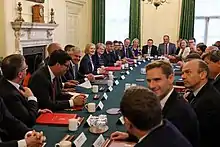
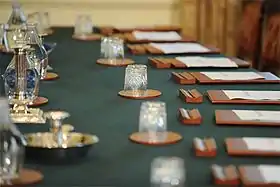
Most cabinet meetings take place in the Cabinet Room of 10 Downing Street; however, they have been known to take place in other places.[1]
Despite the custom of meeting on a Thursday, after the appointment of Gordon Brown, the meeting day was switched to Tuesday.[14] However, when David Cameron became prime minister, he held his cabinet meetings on Thursdays again. Upon Theresa May's tenure, she switched the cabinet meetings back to Tuesday.[15]
The length of meetings varies according to the style of the prime minister and political conditions, but modern meetings can be as short as 30 minutes. Ministers are bound by the constitutional convention of collective ministerial responsibility.[16]
Importance
Cabinet ministers, like all ministers, are appointed and may be dismissed by the monarch without notice or reason, on the advice of the prime minister. The allocation and transfer of responsibilities between ministers and departments is also generally at the prime minister's discretion. The Cabinet has always been led by the prime minister, whose originally unpaid office as such was traditionally described as merely primus inter pares (first among equals), but today the prime minister is the preeminent head of government, with the effective power to appoint and dismiss Cabinet ministers and to control the Cabinet's agenda. The extent to which the Government is collegial varies with political conditions and individual personalities.
The Cabinet is the ultimate decision-making body of the executive within the Westminster system of government in traditional constitutional theory. This interpretation was originally put across in the work of 19th century constitutionalists such as Walter Bagehot, who described the Cabinet as the "efficient secret" of the British political system in his book The English Constitution. The political and decision-making authority of the cabinet has been gradually reduced over the last several decades, with some claiming its role has been usurped by a "prime ministerial" government. In the modern political era, the prime minister releases information concerning the ministerial ranking in the form of a list detailing the seniority of all Cabinet ministers.[17]
The centralisation of the Cabinet in the early 20th century enhanced the power of the prime minister, who moved from being the primus inter pares of the Asquith Cabinets of 1906 onwards, to the dominating figures of David Lloyd George, Stanley Baldwin and Winston Churchill.
The Institute for Government claims that the reduced number of full Cabinet meetings signifies "that the role of Cabinet as a formal decision-making body has been in decline since the war."[18] This view has been contradicted by Vernon Bogdanor, a British constitutional expert, who claims that "the Cabinet has, in fact, been strengthened by the decline in full meetings, as it allows more matters to be transferred to cabinet committees. Thus, business is done more efficiently."[19]
Most prime ministers have had a so-called "kitchen cabinet" consisting of their own trusted advisers who may be Cabinet members but are often non-cabinet trusted personal advisers on their own staff. In recent governments, generally from Margaret Thatcher, and especially in that of Tony Blair, it has been reported that many or even all major decisions have been made before cabinet meetings. This suggestion has been made by former ministers including Clare Short and Chris Smith, in the media, and was made clear in the Butler Review, where Blair's style of "sofa government" was censured.
The combined effect of the prime minister's ability to control Cabinet by circumventing effective discussion in Cabinet and the executive's ability to dominate parliamentary proceedings places the British prime minister in a position of great power, that has been likened to an elective dictatorship (a phrase coined by Quinton Hogg, Lord Hailsham in 1976). The relative inability of Parliament to hold the Government of the day to account is often cited by the UK media as a justification for the vigour with which they question and challenge the Government.[20]
The classic view of Cabinet Government was laid out by Walter Bagehot in The English Constitution (1867) in which he described the prime minister as the primus‐inter‐pares ("first among equals").[21] The view was questioned by Richard Crossman in The Myths of Cabinet Government (1972) and by Tony Benn. They were both members of the Labour governments of the 1960s and thought that the position of the prime minister had acquired more power so that prime ministerial government was a more apt description.[21] Crossman stated that the increase in the power of the prime minister resulted from power of centralised political parties, the development of a unified civil service, and the growth of the prime minister's private office and Cabinet secretariat.[22]
Graham Allen (a government whip during Tony Blair's first government) makes the case in The Last Prime Minister: Being Honest About the UK Presidency (2003) that the office of prime minister has presidential powers,[23] as did Michael Foley in The British Presidency (2000).[24] However the power that a prime minister has over his or her cabinet colleagues is directly proportional to the amount of support that they have with their political parties and this is often related to whether the party considers them to be an electoral asset or liability. Also when a party is divided into factions a prime minister may be forced to include other powerful party members in the Cabinet for party political cohesion. The prime minister's personal power is also curtailed if their party is in a power-sharing arrangement, or a formal coalition with another party (as happened in the coalition government of 2010 to 2015).[22][21][25]
Cabinet
As of 25 October 2022, the makeup of the Cabinet (in order of ministerial ranking) was:[7][26]
Sunak Ministry | ||||
| Incumbent | Office(s) | Department | Took Office | |
|---|---|---|---|---|
| Cabinet ministers | ||||
.jpg.webp) |
The Right Honourable Rishi Sunak Member of Parliament for Richmond (Yorks) (born 1980) |
Prime Minister First Lord of the Treasury Minister for the Union Minister for the Civil Service |
Cabinet Office | 25 October
2022 (0 days ago) |
 |
The Right Honourable Dominic Raab Member of Parliament for Esher and Walton (born 1974) |
Deputy Prime Minister Secretary of State for Justice |
Ministry of Justice | 25 October
2022 (0 days ago) |
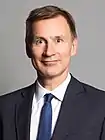 |
The Right Honourable Jeremy Hunt MP for South West Surrey (born 1966) |
Chancellor of the Exchequer | HM Treasury | 14 October 2022 |
.jpg.webp) |
The Right Honourable James Cleverly MP for Braintree (born 1969) |
Secretary of State for Foreign, Commonwealth and Development Affairs |
Foreign Office | 6 September 2022 |
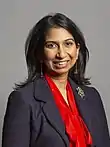 |
The Right Honourable Suella Braverman MP for Fareham (born 1980)[27] |
Secretary of State for the Home Department |
Home Office | 25 October 2022 |
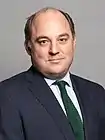 |
The Right Honourable Ben Wallace MP for Wyre and Preston North (born 1970) |
Secretary of State for Defence |
Ministry of Defence | 24 July 2019 |
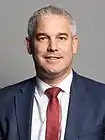 |
The Right Honourable Steve Barclay MP for North East Cambridgeshire (born 1972) |
Secretary of State for Health and Social Care | Department of Health and Social Care | 25 October 2022 |
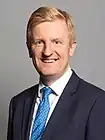 |
The Right Honourable Oliver Dowden MP for Hertsmere (born 1978) |
Chancellor of the Duchy of Lancaster | Cabinet Office | 25 October 2022 |
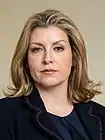 |
The Right Honourable Penny Mordaunt MP for Portsmouth North (born 1973) |
Leader of the House of Commons Lord President of the Council |
Office of the Leader of the House of Commons[lower-alpha 1] | 6 September 2022 |
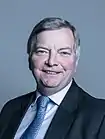 |
The Right Honourable Nicholas True The Lord True CBE (born 1951) |
Leader of the House of Lords Lord Keeper of the Privy Seal |
Office of the Leader of the House of Lords[lower-alpha 2] | 6 September 2022 |
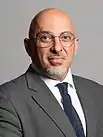 |
The Right Honourable Nadhim Zahawi MP for Stratford-on-Avon (born 1967) |
Chairman of the Conservative Party Minister without Portfolio |
Cabinet Office | 25 October 2022 |
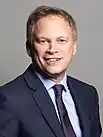 |
The Right Honourable Grant Shapps MP for Welwyn Hatfield (born 1968) |
Secretary of State for Business, Energy and Industrial Strategy |
Department for Business, Energy and Industrial Strategy | 25 October 2022 |
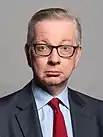 |
The Right Honourable Michael Gove MP for Surrey Heath (born 1967) |
Secretary of State for Levelling Up, Housing and Communities |
Department for Levelling Up, Housing and Communities | 25 October 2022 |
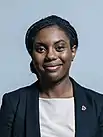 |
The Right Honourable Kemi Badenoch MP for Saffron Walden (born 1980) |
Secretary of State for International Trade President of the Board of TradeMinister for Equalities |
Department for International Trade UK Export Finance |
6 September 2022 |
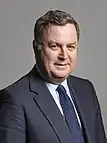 |
The Right Honourable Mel Stride MP for Central Devon (born 1961) |
Secretary of State for Work and Pensions |
Department for Work and Pensions | 25 October 2022 |
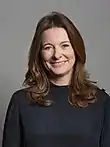 |
The Right Honourable Gillian Keegan MP for Chichester (born 1968) |
Secretary of State for Education |
Department for Education | 25 October 2022 |
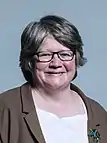 |
The Right Honourable Thérèse Coffey MP for Suffolk Coastal (born 1971) |
Secretary of State for Environment, Food and Rural Affairs |
Department for Environment, Food and Rural Affairs | 25 October 2022 |
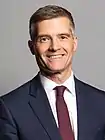 |
The Right Honourable Mark Harper MP for Forest of Dean (born 1970) |
Secretary of State for Transport |
Department for Transport | 25 October 2022 |
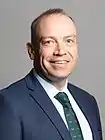 |
The Right Honourable Chris Heaton-Harris MP for Daventry (born 1967) |
Secretary of State for Northern Ireland |
Northern Ireland Office | 6 September 2022 |
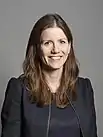 |
The Right Honourable Michelle Donelan MP for Chippenham (born 1984) |
Secretary of State for Digital, Culture, Media and Sport |
Department for Digital, Culture, Media and Sport | 6 September 2022 |
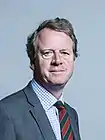 |
The Right Honourable Alister Jack MP for Dumfries and Galloway (born 1963) |
Secretary of State for Scotland |
Scotland Office | 24 July 2019 |
| Vacant | Secretary of State for Wales |
Wales Office | 25 October 2022 | |
| Ministers who also attend Cabinet | ||||
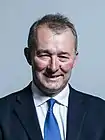 |
The Right Honourable Simon Hart MP for Carmarthen West and South Pembrokeshire (born 1977) |
Parliamentary Secretary to the Treasury (Government Chief Whip) |
HM Treasury[lower-alpha 3] | 25 October 2022 |
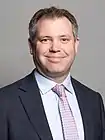 |
The Right Honourable Edward Argar MP for Charnwood (born 1977) |
Chief Secretary to the Treasury | HM Treasury | 14 October 2022 |
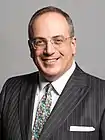 |
The Right Honourable Michael Ellis MP for Northampton North (born 1967) |
Attorney General for England and Wales Advocate General for Northern Ireland |
Attorney General's Office | 6 September 2022 |
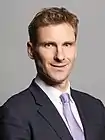 |
The Right Honourable Chris Philp MP for Croydon South (born 1976) |
Minister for the Cabinet Office Paymaster General |
Cabinet Office | 14 October 2022 |
| Vacant | Minister of State for Development | Foreign Office | 25 October 2022 | |
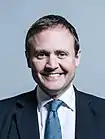 |
The Right Honourable Tom Tugendhat MBE MP for Tonbridge and Malling (born 1973) |
Minister of State for Security | Home Office | 6 September 2022 |
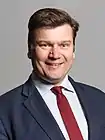 |
The Right Honourable James Heappey MP for Wells (born 1981) |
Minister of State for the Armed Forces and Veterans | Ministry of Defence | 13 February 2020[lower-alpha 4] |
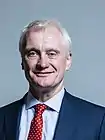 |
The Right Honourable Graham Stuart MP for Beverley and Holderness (born 1962) |
Minister of State for Climate | Department for Business, Energy and Industrial Strategy | 6 September 2022 |
List of Cabinets since 1900
- Cabinets of the Unionist government, 1895–1905
- Cabinets of Henry Campbell-Bannerman's ministry, 1905–1908
- Cabinets of H. H. Asquith's ministries, 1908–1915
- Cabinets of H. H. Asquith's coalition ministry, 1915–1916
- Cabinets of David Lloyd George's ministries, 1916–1922
- Cabinets of Bonar Law's ministry, 1922–1923
- Cabinets of Stanley Baldwin's first ministry, 1923–1924
- Cabinets of Ramsay MacDonald's first ministry, 1924
- Cabinets of Stanley Baldwin's second ministry, 1924–1929
- Cabinets of Ramsay MacDonald's second ministry, 1929–1931
- Cabinets of Ramsay MacDonald's first national government, 1931
- Cabinets of Ramsay MacDonald's second national government, 1931–1935
- Cabinets of Stanley Baldwin's national government, 1935–1937
- Cabinets of Neville Chamberlain's national government, 1937–1939
- Cabinets of Neville Chamberlain's war ministry, 1939–1940
- Cabinets of Winston Churchill's war ministry, 1940–1945
- Cabinets of Winston Churchill's caretaker ministry, 1945
- Cabinets of Clement Attlee's first ministry, 1945–1950
- Cabinets of Clement Attlee's second ministry, 1950–1951
- Cabinets of Winston Churchill's third ministry, 1951–1955
- Cabinets of Anthony Eden's ministry, 1955–1957
- Cabinets of Harold Macmillan's first ministry, 1957–1959
- Cabinets of Harold Macmillan's second ministry, 1959–1963
- Cabinets of Alec Douglas-Home's ministry, 1963–1964
- Cabinets of Harold Wilson's first and second ministries, 1964–1970
- Cabinets of Ted Heath's ministry, 1970–1974
- Cabinets of Harold Wilson's third and fourth ministries, 1974–1976
- Cabinets of James Callaghan's ministry, 1976–1979
- Cabinets of Margaret Thatcher's first ministry, 1979–1983
- Cabinets of Margaret Thatcher's second ministry, 1983–1987
- Cabinets of Margaret Thatcher's third ministry, 1987–1990
- Cabinets of John Major's first ministry, 1990–1992
- Cabinets of John Major's second ministry, 1992–1997
- Cabinets of Tony Blair's first ministry, 1997–2001
- Cabinets of Tony Blair's second ministry, 2001–2005
- Cabinets of Tony Blair's third ministry, 2005–2007
- Cabinets of Gordon Brown's ministry, 2007–2010
- Cabinets of the Cameron–Clegg coalition, 2010–2015
- Cabinets of David Cameron's second ministry, 2015–2016
- Cabinets of Theresa May's first ministry, 2016–2017
- Cabinets of Theresa May's second ministry, 2017–2019
- Cabinets of Boris Johnson's first ministry, 2019
- Cabinets of Boris Johnson's second ministry, 2019–2022
- Cabinets of Liz Truss's ministry, September 2022 - October 2022
- Rishi Sunak's Cabinet
See also
- British Government frontbench
- United Kingdom cabinet committee
- Official Opposition Shadow Cabinet
Notes
- The Office of the Leader of the House of Commons is a ministerial department of the Cabinet Office.
- The Office of the Leader of the House of Lords is a ministerial department of the Cabinet Office.
- Technically a part of the Treasury, but de facto a part of a semi-independent whips office supported by the Cabinet Office
- Member of Cabinet since 6 September 2022
References
- Durrant, Tim (31 March 2021). "Cabinet". Institute for Government. Archived from the original on 27 June 2020. Retrieved 18 August 2021.
- "Ministerial Code" (PDF). gov.uk. August 2019. p. 4. Archived (PDF) from the original on 6 September 2019. Retrieved 20 April 2021.
- OED Cabinet
- "The Harvard Classics. 1909-14. > Francis Bacon > Essays, Civil and Moral. XX. Of Counsel". bartleby.com. Archived from the original on 4 March 2016.
- "The Cabinet Manual" (PDF). Government of the United Kingdom. October 2011. p. 22. Archived (PDF) from the original on 15 April 2018. Retrieved 18 August 2021.
- Rhodes, Chris; Watson, Chris (6 August 2021). "Limitations on the number of Ministers" (PDF). Parliament of the United Kingdom. p. 6. Archived (PDF) from the original on 11 June 2015. Retrieved 18 August 2021.
- "Ministers". Government of the United Kingdom. Retrieved 26 April 2022.
- Jones, Elwyn (April 1969). "The Office of Attorney-General". Cambridge Law Journal. 27 (1): 47. doi:10.1017/S0008197300088899. S2CID 145400357.
- Hennessy, Peter (2000). The Prime Minister: The Office and its Holders Since 1945. Penguin. p. 47. ISBN 978-0140283938.
- Hennessy, Peter (2000). The Prime Minister: The Office and its Holders Since 1945. Penguin. pp. 47–8. ISBN 978-0140283938.
- "How members are appointed". Parliament of the United Kingdom. Archived from the original on 12 May 2012. Retrieved 18 August 2021.
- "Times letters: Mark Sedwill's call for a cull of the cabinet". The Times. ISSN 0140-0460. Retrieved 30 November 2020.
- "Rodney Brazier: Why is Her Majesty's Government so big?". UK Constitutional Law Association. 7 September 2020. Retrieved 30 November 2020.
- Jones, George (2 July 2007). "Cabinet moves to Tuesdays". The Daily Telegraph. Archived from the original on 12 January 2022.
- "David Cameron coalition team in first cabinet meeting". BBC News. 13 May 2010. Retrieved 15 June 2017.
- Zodgekar, Ketaki (4 November 2019). "Collective responsibility". Institute for Government. Archived from the original on 3 October 2020. Retrieved 18 August 2021.
- "MPs and Lords". Her Majesty's Government.
- Andrew, Blick; George, Jones (7 June 2010). "Policy Papers | The power of the Prime Minister > Measuring Cabinet government". historyandpolicy.org. Archived from the original on 7 November 2015. Retrieved 13 April 2022.
- "Vernon Bogdanor: Britain is in the process of developing a constitution". Independent.co.uk. Archived from the original on 30 October 2014. Retrieved 28 September 2014.
- "Newspaper support in general elections". The Guardian. 4 May 2010.
- Fairclough, Paul (2002). "6.1 The Primemister". Advanced Government and Politics. Oxford University Press. ISBN 978-0-19-913434-2.
- Williams, Andy (1998). "Prime ministerial government". UK Government & Politics. Heinemann. pp. 113–114. ISBN 978-0-435-33158-0.
- Allen, Graham (14 February 2017). The Last Prime Minister: Being Honest About the UK Presidency. Andrews UK Limited. ISBN 978-1-84540-609-7.
- Foley, Michael (2000). "Chapter 1: The Blair revolution and presidential standard". The British Presidency. Manchester University Press. pp. 1-26. ISBN 978-0-7190-5016-9.
- Palekar, S.A. (2008). "Position of the Prime Minister". Comparative Politics and Government. PHI Learning Pvt. Ltd. p. 37. ISBN 978-81-203-3335-2.
- "Her Majesty's Government: The Cabinet". Parliament of the United Kingdom. Retrieved 26 April 2022.; Durrant, Tim; Tingay, Paeony (10 February 2022). "Downing Street chief of staff". Institute for Government. Retrieved 26 April 2022.; "FOI2021 07221 REPLY.pdf". 26 April 2021. Archived from the original on 27 April 2021. Retrieved 8 June 2021.; "Office of the Leader of the House of Commons". Government of the United Kingdom. Retrieved 26 April 2022.; "Office of the Leader of the House of Lords". Government of the United Kingdom. Retrieved 26 April 2022.
- "Grants Shapps replaces Suella Braverman as home secretary". bbc.co.uk. BBC. Retrieved 19 October 2022.
External links
- Cabinet Office - Main Site
- Cabinet Office - UK Executive
- Cabinet Office - List of Cabinet Ministers
- Cabinet Papers, 1915-1981 (National Archives)
- BBC news website - The Cabinet

.svg.png.webp)